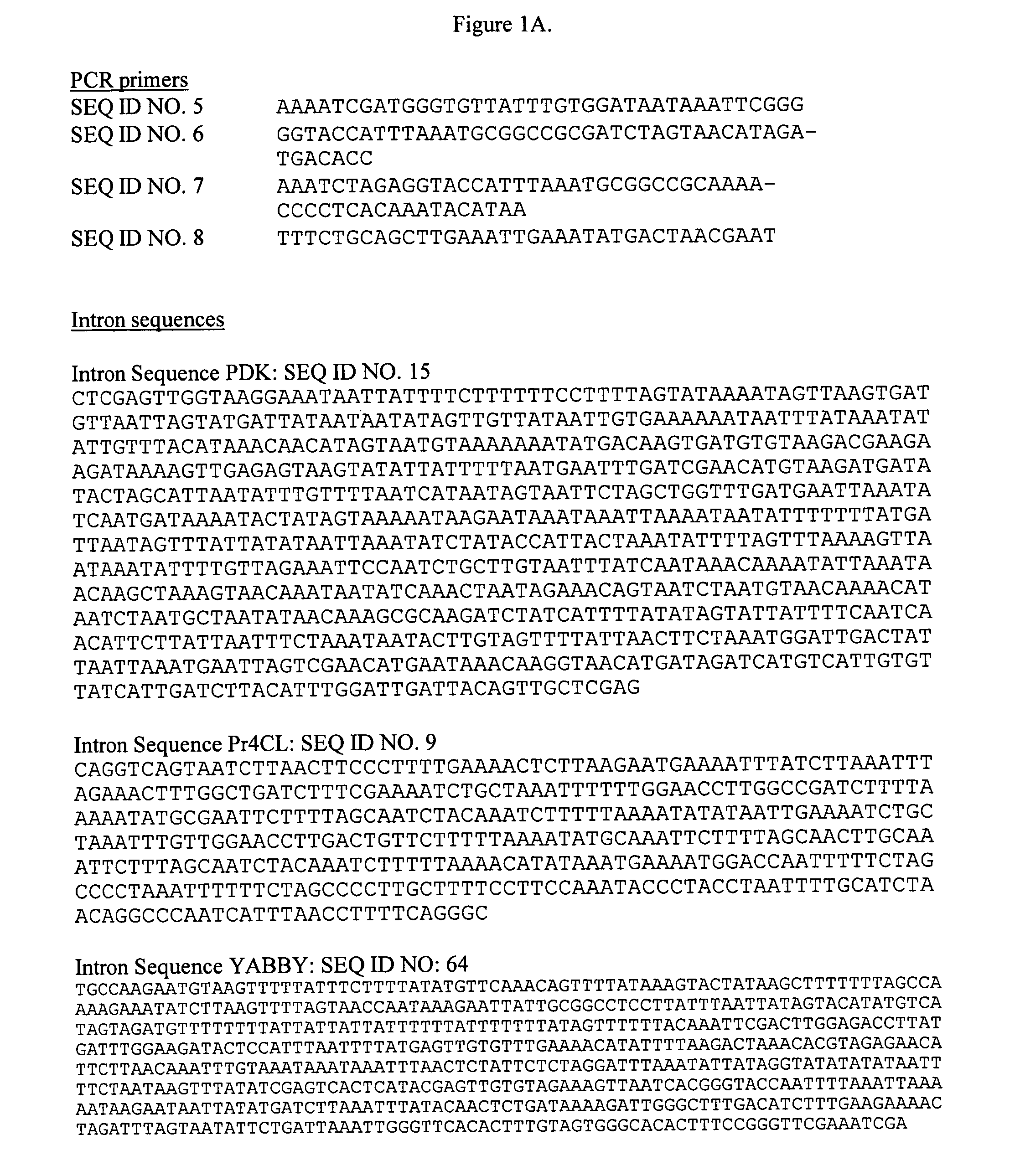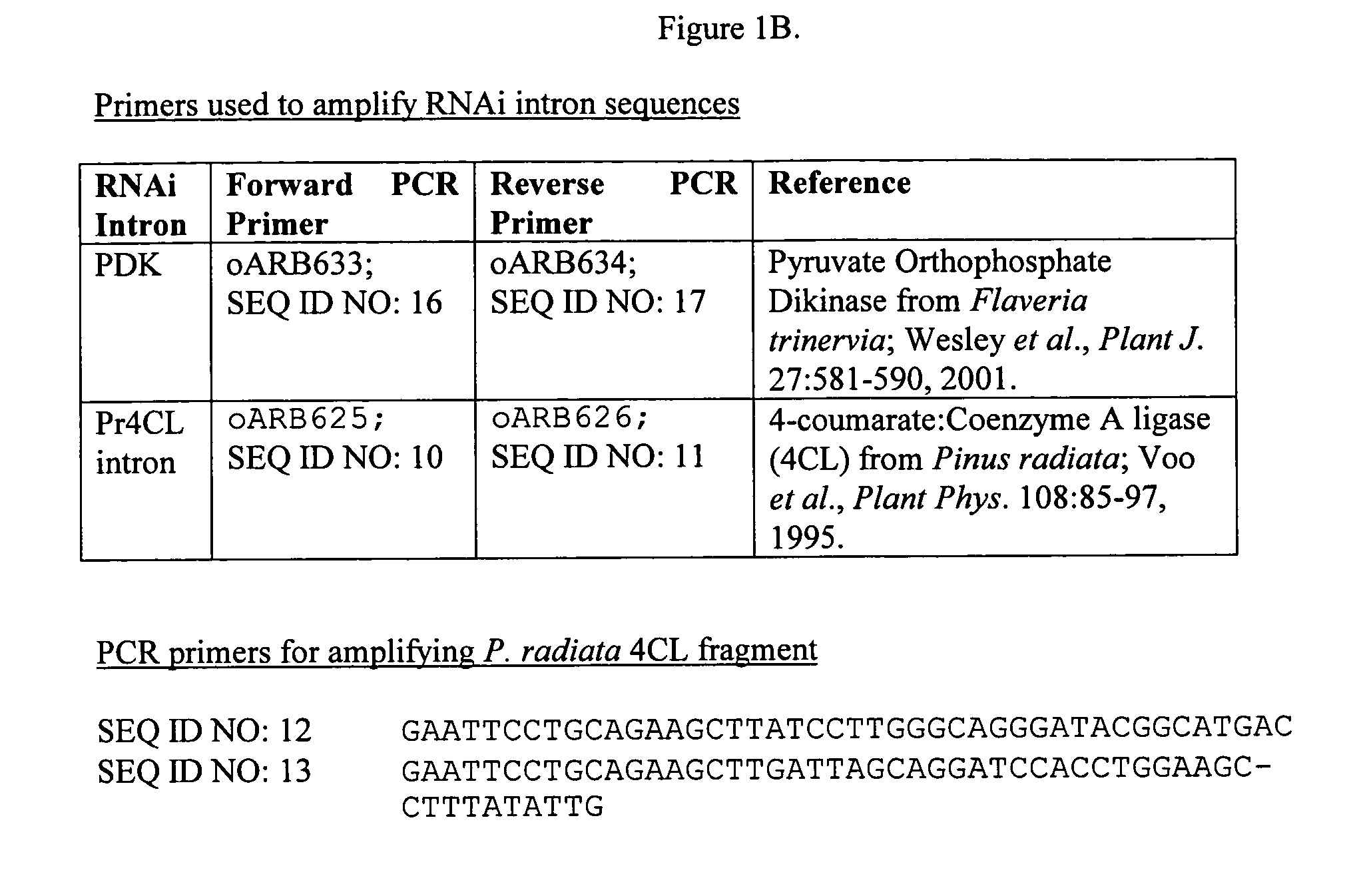Modification of plant lignin content
a technology of plant lignin and lignin content, which is applied in the field of genetically modified plants, can solve the problems of affecting the process of converting wood into paper, and affecting the phenotype of plants,
- Summary
- Abstract
- Description
- Claims
- Application Information
AI Technical Summary
Benefits of technology
Problems solved by technology
Method used
Image
Examples
example 1
Construction of cDNA Libraries
[0067] To identify monolignol synthesis, monolignol transport, and lignin polymerization gene candidates in P. radiata and E. grandis databases, cDNA sequences were compared to public domain sequences (by SWISS-PROT / TrEMBL ID's) to search against the pine and eucalyptus databases (non-redundant by contig, expect<1.0e-2).
[0068] The contig consensus DNA and protein sequences were then obtained for these hits, and duplicate sequences were identified. A multiple alignment was then carried out with the protein sequences. The protein alignment was created using the remaining pine and eucalyptus sequences along with the Arabidopsis members. From the protein alignment, a dendogram was created. These sequences were analyzed by primer walking to provide a full length sequence (best HT pick from the contig analyzed for full length sequence).
[0069] The public domain monolignol synthesis, monolignol transport, and lignin polymerization gene sequences from maize, ...
example 2
Construction of Pine 4CL Expression Vectors
[0078] A series of recombinant constructs comprising at least a portion of a 4CL gene from loblolly pine were prepared and evaluated for their ability to reduce the lignin content in plants. In general, each DNA construct comprises a promoter operably linked to a first DNA segment that corresponds to at least a portion of a 4CL gene, a spacer DNA segment, and a second DNA segment that is complementary to the first DNA segment, wherein the first and second DNA segments are arranged in a 5′ to 3′ direction, respectively, in the DNA construct. Eleven constructs were designed and prepared using different fragments of the 4CL gene Pinus radiata (FIG. 5) and different promoters. The general designs for the constructs are depicted in FIGS. 7 to 9. The superubiquitin promoter (U.S. Pat. No. 6,380,459, Ranjan J Perera et al., Plant & Animal Genome VIII Conference (2000)) was used as a constitutive promoter, while a 4CL promoter from P. taeda (U.S. ...
example 3
Construction of Eucalyptus 4CL Expression Vectors
[0097] A series of recombinant constructs comprising at least a portion of a 4CL gene were prepared as described above and evaluated for their ability to reduce the lignin content in plants. In general, each DNA construct comprises a promoter operably linked to a first DNA segment (SEQ ID NO: 21) that corresponds to at least a portion of a 4CL gene from Eucalyptus grandis (U.S. Pat. No. 6,410,718) a spacer DNA segment, and a second DNA segment that is complementary to the first DNA segment, wherein the first and second DNA segments are arranged in a 5′ to 3′ direction, respectively, in the DNA construct. Initially, three constructs were prepared using different fragment lengths of the 4CL gene and different promoters. See Table 11. The general design for the constructs is depicted in FIG. 7. The superubiquitin promoter (U.S. Pat. No. 6,380,459; Ranjan J Perera et al., Plant & Animal Genome VIII Conference (2000)) was used as a consti...
PUM
| Property | Measurement | Unit |
|---|---|---|
| height | aaaaa | aaaaa |
| temperature | aaaaa | aaaaa |
| diameter | aaaaa | aaaaa |
Abstract
Description
Claims
Application Information
 Login to View More
Login to View More - R&D
- Intellectual Property
- Life Sciences
- Materials
- Tech Scout
- Unparalleled Data Quality
- Higher Quality Content
- 60% Fewer Hallucinations
Browse by: Latest US Patents, China's latest patents, Technical Efficacy Thesaurus, Application Domain, Technology Topic, Popular Technical Reports.
© 2025 PatSnap. All rights reserved.Legal|Privacy policy|Modern Slavery Act Transparency Statement|Sitemap|About US| Contact US: help@patsnap.com



